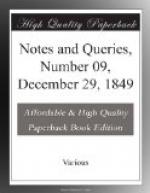“There are three bondmen of bloude belonginge unto this manor, never known to be anie way mannumissed, namely, Thomas Goringe, William and John Goringe. Thomas Goringe dwells at Amberley, William at Piddinghow, and John Goringe at Rottingdean. What goods they have the Jurie know not. All poor men. Thomas hath the reversion of a cotage now in the tenure of William Jefferye. But mee thinks this kinde of advantage is nowe out of season; yet, were they men of ability, they might be, upon some consideration, infraunchized.” (Survey of the Manor of Falmer, Sussex.)
I shall be glad to know whether any more recent instance can be pointed out.
E. SMIRKE.
* * * * *
THE DORE OF HOLY SCRIPTURE.
In Herbert’s edition of Ames’s Typographical Antiquities, 1785, vol. i. p. 492., is noticed The Dore of Holy Scripture, 12mo., printed by John Gowghe in 1536; and, at p. 494., a reprint of the same work is mentioned in 1540, by the same printer, and a description of a copy given from one then in the possession of Herbert himself. In the preface prefixed by the printer, he calls the work “the prologue of the fyrste translatoure of the byble out of latyn in to Englyshe;” and at the end of the work is this note:—“Perused by doctor Taylor and doctor Barons, Master Ceton and Master Tornor.” As I am much interested in the subject to which this publication refers, may I ask for information on three points?—1. What evidence is there of this edition of 1536, beyond the statement in Ames? 2. What has become of the copy of the edition of 1540, formerly belonging to Herbert? and, 3. Who are the persons who peruse and revise the latter edition? There is not copy of either edition, as far as I can trace, in the British Museum, in the Bodleian, or at Lambeth.
I may add to these queries the following remarks:—
1. Ames asserted that The Dore of Holy Scripture was among the books prohibited to be read {140} by the injunctions of Henry the Eighth, and refers, as his authority, to Foxe’s Acts and Monument, ed. 1562, p. 574. Herbert, in a note, questions the fact, and raises a doubt as to the existence of the passage in Foxe, since it is not in the edition of 1641. I have, however, the first edition now before me of 1563 (not 1562), and at p. 574., among “the names of certen bokes whiche after this injunction [namely, of 1539], or some other in the said kinges dayes were prohybited,” occurs, “Item, the doore of holy scripture. made by Jhon. Gowghe.”
2. This work was again printed by Crowley in 1550, 12mo., under a different title, namely, The Pathway to Perfect Knowledge; and in the preface, he falsely ascribes it to John Wycliffe, and adds, “the original wherof is in an olde English Bible, betwixt the Olde Testament and the Newe, which Bible remaineth now in the Kyng his Majesties chamber.” This Bible appears to be the identical manuscript copy of the later Wycliffe version of the Scriptures, now preserved in the University Library, Cambridge, and marked Mm 2. 15. A copy of Crowley’s edition is in the British Museum, but the orthography and language of the tract are modernised.




